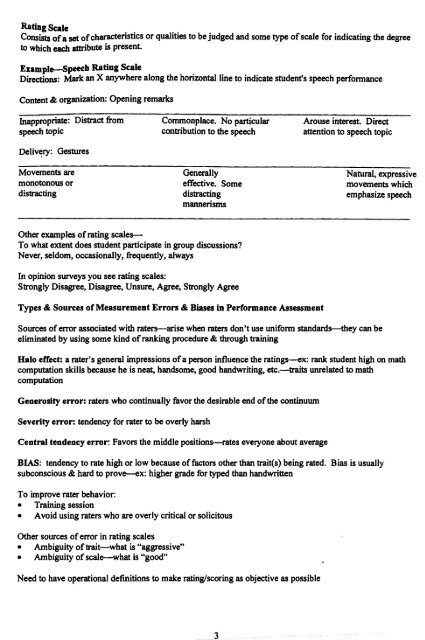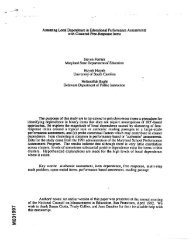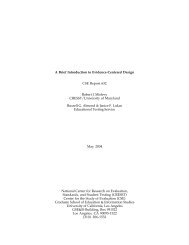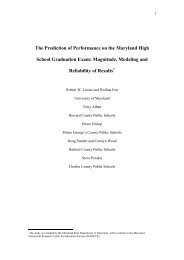Anonymous (XXXX) Rubric scoring and item writing.pdf
Anonymous (XXXX) Rubric scoring and item writing.pdf
Anonymous (XXXX) Rubric scoring and item writing.pdf
You also want an ePaper? Increase the reach of your titles
YUMPU automatically turns print PDFs into web optimized ePapers that Google loves.
3<br />
Rating Scale<br />
Consists ofa set ofcharacteristics or qualities to be judged <strong>and</strong> some type ofscale for indicating the degree<br />
to which each attribute is present.<br />
Example-Speeeb Rating Seale<br />
Directions: Mark an X anywhere along the horizontal line to indicate student's speech performance<br />
Content & organization: Opening remarks<br />
Inappropriate: Distract from<br />
speech topic<br />
Commonplace. No particular<br />
contribution to the speech<br />
Arouse interest. Direct<br />
attention to speech topic<br />
Deliv~ry:<br />
Gestures<br />
Movements are<br />
monotonous or<br />
distracting<br />
Generally<br />
effective. Some<br />
distracting<br />
mannerisms<br />
Natural, expressive<br />
movements which<br />
emphasize speech<br />
Other examples ofrating scales-<br />
To what extent does student participate in group discussions?<br />
Never, seldom, occasionally, frequently, always<br />
In opinion surveys you see rating scales:<br />
Strongly Disagree, Disagree, Unsure, Agree, Strongly Agree<br />
Types & Sources ofMeasurement Erron & Biases in Performance Assessment<br />
Sources oferror associated with raters-arise when raters don't use uniform st<strong>and</strong>ards--they can be<br />
eliminated by using some kind ofranking procedure & thrOlJgh training<br />
Halo effect: a rater's general impressions ofa person influence the ratings--ex: rank student high on math<br />
computation skills because he is neat, h<strong>and</strong>some, good h<strong>and</strong><strong>writing</strong>, etc.-traits unrelated to math<br />
computation<br />
Generosity error: raters who continually favor the desirable end ofthe continuum<br />
Severity error: tendency for rater to be overly harsh<br />
Central tendency error: Favors the middle positions--rates everyone about average<br />
BIAS: tendency to rate high or low because offactors other than trait(s) being rated. Bias is usually<br />
subconscious & hard to prove-ex: higher grade for typed than h<strong>and</strong>written<br />
To improve rater behavior:<br />
• Training session<br />
• Avoid using raters who are overly critical or solicitous<br />
Other sources oferror in rating scales<br />
• Ambiguity oftrait-what is "aggressive"<br />
• Ambiguity ofscale-what is "good"<br />
Need to have operational defmitions to make rating/<strong>scoring</strong> as objective as possible






